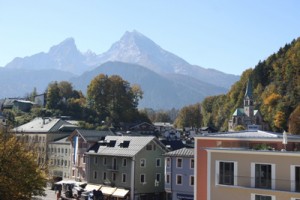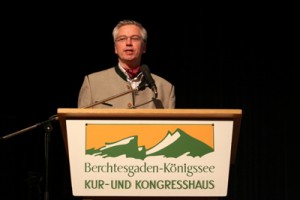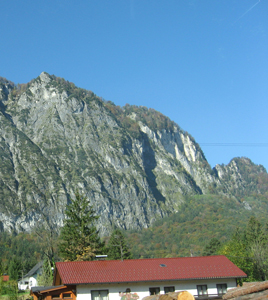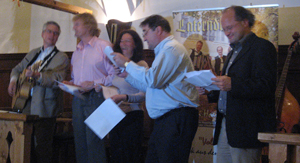The 3rd Asia-Oceania Conference on Green and Sustainable Chemistry (AOC-3) will be held in Melbourne, Australia on December 4 – 7, 2011. The aim of the conference is to provide a platform for interaction and exchange of ideas between practitioners in Green Chemistry, and to promote Green Chemistry in the Asia-Oceania region. Program highlights will include presentations by the ‘father of green chemistry’, Dr Paul Anastas and 2010 Nobel Prize Winner, Dr Akira Suzuki. Abstract submission is still open for oral consideration and earlybird rates are available. Please visit http://www.greenoz2011.org/ to register and lodge your abstract!
Archive for the ‘Conference’ Category
2011 Presidential Green Chemistry Challenge Awards
For the 16th year, the U.S. Environmental Protection Agency is recognizing pioneering chemical technologies developed by leading researchers and industrial innovators who are making significant contributions to pollution prevention in the United States. These prestigious awards recognise and promote research and development of less-hazardous alternatives to existing technologies that reduce or eliminate waste, particularly hazardous waste, in industrial production.
The Presidential Green Chemistry Challenge Awards are bestowed in five categories. Green Chemistry would like to congratulate the 2011 award winners:
- Academic: Bruce H. Lipshutz, PhD, University of California, Santa Barbara
- Small business: BioAmber, Inc., Plymouth, Minn.
- Greener synthetic pathways: Genomatica, San Diego, Calif.
- Greener reaction conditions: Kraton Performance Polymers, Inc., Houston, Texas
- Designing greener chemicals: The Sherwin-Williams Company, Cleveland, Ohio
The awards were made on Monday night, June 20th at the Green Chemistry Challenge Awards ceremony in Washington D.C. as an opener to the 15th Annual Green Chemistry & Engineering Conference which is being held in concert with the 5th International Conference on Green & Sustainable Chemistry.
Green Chemistry Editor Sarah Ruthven is in Washington D.C. attending the Conferences; if you would like to meet her there please contact the Editorial Office.
Green Solvents for Synthesis Conference Report
Conference report by Ewa Gebauer-Henke and Mark Muldoon
The latest issue of Green Chemistry features papers from the “Green Solvents for Synthesis” conference that was held in October 2010. The bi-annual DECHEMA conference on green solvents has a reputation for attracting world leaders in the field of green chemistry and also for being held in beautiful locations in Germany. In 2008, the meeting was held in Friedrichshafen on Lake Constance, while this recent meeting was in the stunning town of Berchtesgaden in the German Bavarian Alps.
Common themes throughout the conference were the use of ionic liquids, water, supercritical fluids (CO2 and water), CO2 expanded solvent systems and solvents from renewable sources. The meeting attracted a mix of industrialists, academics and graduate students from across the globe. Addressing the challenges in this area requires an interdisciplinary approach and attendees had a wide range of scientific and engineering backgrounds. The varied nature of the research presented at this meeting is clear from the contributions to this special issue. For those interested, the full conference programme can still be viewed online.
One of the things that seemed clear from the discussions and debates among participants was that this field is continuing to mature and strive for higher standards. Many of the discussions related to improving the overall greenness of processes and topics such as “life cycle analysis” and “energy” were often raised. The claim that a solvent is intrinsically green in itself is not something that holds up to scrutiny and therefore researchers are having to demonstrate how solvents can be used to improve a process overall; for example by allowing catalyst separation and recycling or delivering improved reaction rates and product selectivity.
The first lecture of the conference by Philip Jessop highlighted many of these issues and set the tone for the meeting. He outlined what he felt were the four “grand challenges” in the field of green solvents. Additionally, he had polled some of the leading academic researchers in the field of solvents prior to the conference, asking them what solvents they felt would have the biggest impact in the coming years. He then discussed the interesting results of this survey during his talk. The details of his lecture can be seen in his paper “Searching for green Solvents”.
Ionic liquids have gathered a great deal of interest in the last decade or so and a number of talks highlighted how these solvents can be used to improve the greenness of a process. For example, Peter Wasserscheid delivered a very well received talk on the topic of ionic liquids in the field of heterogeneous catalysis. He discussed both SILP (“Supported Ionic Liquid Phase”) technology and SCILLs (Solid Catalysts with Ionic Iiquid Layers’). For a number of years, researchers have been investigating the use of SILPs; which involves utilising a thin ionic liquid layer on a solid support to immobilise homogeneous transition metal catalysts. However, more recently, the SCILL approach has emerged, and this involves coating a “traditional” heterogeneous type catalyst with a layer of ionic liquid. The layer of ionic liquid can result in modification of the properties and performance of the heterogeneous catalyst. Peter’s talk illustrated well how ionic liquids could improve catalyst performance, therefore leading to a greener process.
Continuous flow is often the best way to improve the efficiency of a process and “alternative solvent systems” can enable flow processes to be developed in ways not possible with conventional organic solvents. For example, Pedro Lozano described his group’s work on continuous flow enzymatic synthesis of biodiesel in mono- and multiphase systems using a combination of ionic liquids and supercritical CO2. While Lasse Greiner discussed the application of continuous flow systems for the synthesis of ionic liquids. He stressed how the transition from batch to continuous is only possible, when kinetic and thermodynamic studies have been carried out and showed how inline ATR-IR and calorimetry were powerful tools for such studies. He demonstrated that the synthesis of ionic liquids can be realized with consistent product specifications; necessary in large scale production.
The importance of in-situ techniques was also highlighted in Jan-Dierk Grunwald’s talk “Heterogeneous catalysis in dense carbon dioxide: opportunities, limitations and mechanistic understanding”. He presented work on both catalytic hydrogenations and oxidations in dense and supercritical CO2. As part of these studies, ATR-IR was used to determine phase behaviour and X-ray adsorption spectroscopy to study the catalyst under high pressure reaction conditions. Developing an in-depth understanding of reactions in such solvents is important if they are to be fully exploited in an industrial setting.
Ultimately, the aim of green chemistry is to have an impact in the real world and there are an increasing number of industrial processes that now utilise “alternative solvent” technologies. Several examples were highlighted during this conference including those that exploited supercritical water. This was particularly nice to see as this is a solvent system that is often labelled as an academic curiosity. More details of industrial scale processes for scH2O are described in the paper by Adschiri and co-workers.
Solvents play a crucial role to vast number of processes and they are therefore key in developing more sustainable chemical processes. We would highly recommend that researchers interested in the important area of green chemistry attend a future DECHEMA green solvents conference. The next one is scheduled for early October 2012 (and starts just as Oktoberfest in finishing in Munich). As mentioned, these meetings bring together leaders from academia and industry from across a range of disciplines. In fact many of these leading figures not only discuss their research but also entertain the participants! At this past it closed with a traditional Bavarian banquet dinner where some very well known academics entertained the attendees singing that Leitner and Howdle classic “Always Use Green Chemistry Tools”; something, previously highlighted by Kathleen Too in this blog (October 15th entry).
Ewa Gebauer-Henke
CAT Catalytic Center Postdoctoral Fellow
ITMC, RWTH Aachen University
Mark Muldoon
School of Chemistry and Chemical Engineering
Queen’s University Belfast
Pictures, courtesy of Prof Kenneth Seddon (QUILL, Queen’s University of Belfast)
Green Chemistry Themed Issue on Green Solvents Marks the International Year of Chemistry

The issue showcases the innovative research towards the substitution of volatile organic solvents in solution phase synthesis. The series of articles presented in this themed issue are based on the keynote presentations at an international conference organised by Dechema, held in October 2010 in Berchtesgaden, Germany.
You can read Guest Editor Walter Leitner’s editorial online here and the full issue online here.
15th Annual Green Chemistry Conference
Have you registered for the 15th Annual Green Chemistry Conference? With over 600 attendees expected, this premier Conference showcases innovations in all aspects of sustainable chemistry. From June 21-23, mingle with US government representatives, Business executives, R&D managers, marketing and communication experts, sustainability thought leaders, chemical engineers, chemists, international & local students. Attend numerous breakout sessions, networking events while exploring Washington D.C in the summer.
Visit the conference website, www.gcande.org, for updated conference information and to:
- register for the conference until June 10
- make your hotel or student housing reservations
- read important presenter information
- view the online conference program
Posted on behalf of Shefali Algoo, ACS Green Chemistry Institute.
Read the best ionic liquid research from the Asia-Pacific region
Green Chemistry has collated a number of ionic liquid research presented at the recent 2nd Asia Pacific Conference on Ionic Liquids and Green Processes held in Dalian, China, on 7-10 September 2010. The selection of articles below represents some of the best ionic liquid research from the Asia-Pacific region. You can access the web-themed issue online.
Fangmin Jin and co-workers demonstrate the reduction of NaHCO3 to formate using isopropanol as a reducing agent. Yields of about 70% were acheived.
Read more about Fangmin Jin’s work:
From NaHCO3 into formate and from isopropanol into acetone: Hydrogen-transfer reduction of NaHCO3 with isopropanol in high-temperature water
Zheng Shen, Yalei Zhang and Fangming Jin
Green Chem., 2011, DOI:10.1039/C0GC00627K , Advanced Article
A fruitful collaboration between the teams led by Changping Li and Urs Welz-Biermann resulted in the development of a microwave-assisted extraction of bioactive lactones from chinese herbal medicines using protic ionic liquids. The Dalian scientists concluded that the extraction mechanism of microwave-assisted ionic liquid extraction is the similar to traditional organic solvent extraction.
Microwave-assisted extraction of lactones from Ligusticum chuanxiong Hort. using protic ionic liquids
Chi Yansheng, Zhang Zhida, Li Changping, Liu Qingshan, Yan Peifang and Urs Welz-Biermann
Green Chem., 2011, 13, 666-670
In this web-themed issue, Li and Welz-Biermann also report a room-temperature method to desulfurise fuels employing an oxidation method combined with extraction using acidic ionic liquids. The method shows some promise level of sulfur removal from the model oil reached 99% in 180 min.
Interested in finding out more? Read the full article here:
Desulfurization by oxidation combined with extraction using acidic room-temperature ionic liquids
Chi Yansheng, Li Changping, Jiao Qingzhu, Liu Qingshan, Yan Peifang, Liu Xiumei and Urs Welz-Biermann
Green Chem., 2011, DOI: 10.1039/C0GC00745E, Advanced Article
Liu et al. showed that double SO3H-functionalized ionic liquids exhibited better catalytic activity for the esterification of glycerol compared to non-functionalizeds ionic liquids. Glycerol conversion was achieved in 95% within 30 min by using catalytic amounts of ionic liquids (only 0.1 mol% based on glycerol).
You can read the full paper online:
Esterification of glycerol with acetic acid using double SO3H-functionalized ionic liquids as recoverable catalysts
Xiumei Liu, Huiyuan Ma, Yue Wu, Chang Wang, Miao Yang, Peifang Yan and Urs Welz-Biermann
Green Chem., 2011, 13, 697-701
Kim et al. demonstrate an eco-friendly way of making polymers. The Korean scientists synthesized double metal cyanide (DMC) catalysts for the ring opening polymerization of propylene oxide, employing nontoxic lactate esters as complexing agents. “Highly pure polyol products that can be raw materials for high performance polymers like polyurethane are produced by using the resulting catalysts,” claim Kim and co-workers.
Double metal cyanide catalysts bearing lactate esters as eco-friendly complexing agents for the synthesis of highly pure polyols
Ji Hwan Yoon, In Kyu Lee, Hye Yoon Choi, Eun Ji Choi, Ju Ho Yoon, Sang Eun Shim and Il Kim
Green Chem., 2011, 13, 631-639
African Green Chemistry congress makes the headlines
The first PACN Green Chemistry Congress took place in Addis Ababa, Ethiopia, on the 15th –17th November 2010. The international event was organised by the RSC Pan Africa Chemistry Network (www.rsc.org/pacn) with support from Green Chemistry. The congress received fantastic media coverage in countries across the African continent and the rest of the world.
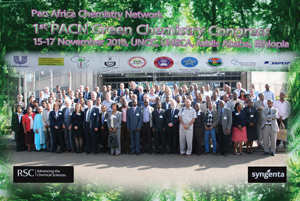 The Green Chemistry Congress was opened by the Ethiopian Minister for Water and Energy, H.E. Ato Alemaghu Tegenu. During the event, Tegenu wrote an opinion piece that highlighted the need for science and innovation to improve African people’s lives sustainably, and the important role of the RSC and the Pan Africa Chemistry Network in supporting these scientific developments. This piece was published both in print and online in 13 different newspapers across Africa. To read the piece online, click here.
The Green Chemistry Congress was opened by the Ethiopian Minister for Water and Energy, H.E. Ato Alemaghu Tegenu. During the event, Tegenu wrote an opinion piece that highlighted the need for science and innovation to improve African people’s lives sustainably, and the important role of the RSC and the Pan Africa Chemistry Network in supporting these scientific developments. This piece was published both in print and online in 13 different newspapers across Africa. To read the piece online, click here.
Green Chemistry Advisory Board member, Yonas Chebude, chaired the local organizing committee. In addition to a number of distinguished scientists from all around the world, both the Chair of the Editorial Board, Martyn Poliakoff, and the Scientific Editor, Walter Leitner, spoke at the Congress, as well as Editorial Board members Buxing Han, Paul Anastas and Tom Welton. The Congress was very well attended with delegates from 22 countries.
One of the main outcomes of the Congress is the writing of a report which will include recommendations. Once the report is finalised we will announce it on the Green Chemistry website.
Singing Green Chemistry tools in Germany
The Green Solvents for Synthesis conference started on Sunday the 10th October 2010 with a boat trip on Lake Königsee which I was told was absolutely spectacular with plenty of mountain landscape. The lake was described as the purest of all “green solvents” being a gorgeous emerald green in colour.
The delegates were then gathered for a welcome reception in the evening and an opening lecture delivered by Phil Jessop (Queen’s University, Canada) where he described the progress made in green solvents and categorised them in three areas: Replacement green solvents, Really green solvents, and Revolutionary green solvents. His comments were that the replacement solvents may not be enough to cover the different needs. Some solvents have been assessed thoroughly and found to be really green, but most “green” solvents have not been assessed.
On the first day of the conference, Peter Dunn of Pfizer Ltd gave us a broad overview of organic reactions carried out in water. Other talks of interest were by Takao Ikariya (Tokyo institute of Technology) on the use carbon dioxide as green solvent and reactant for organic reactions and Tadafumi Adschiri (Tohoku University) who brought along samples of the super hybrid materials made in his lab via supercritical routes. This was followed by a lecture by Andreas Jess (University of Bayreuth, Germany) on the evaporation and thermal decomposition of ionic liquids by thermogravimetry at ambient pressure and UHV. The afternoon ended with an inspiring lecture by Peter Wassercheid (University of Erlangen-Nuremberg) on ionic liquids and heterogeneous catalysis and his recent progress on supported ionic liquid phase (SILP) and supported catalyst with an ionic liquid layer (SCILL). A poster session then followed with winners to be announced shortly.
The highlights of the second day were talks by Dieter Vogt (TU Eindhoven) on homogeneous catalysis and amine formations, followed by Alberto Puga (QUILL, Belfast) on new 6-membered piperidine and 7-membered azepane derived ionic liquids. It became clear that toxicity is an important factor in determining the “greenness” of new ionic liquids. Other talks of interest were algae lipids for biodiesel production delivered by Lindsay Soh (PhD student at Yale University) and fluorous solvents for catalyst recovery, activation and product protection given by John Gladysz (Texas A&M University).
The delegates were spoilt for choices for lunch at either traditional Bavarian style restaurants or small cafes with plenty of outdoor seating to soak up the sun and the magnificent mountain views. The afternoon session resumed with an awe-inspiring talk by Steve Howdle (University of Nottingham, UK) where he used supercritical fluids to synthesize green polymers which were used in bone grafting and drug delivery. We later learnt that Steve, who is a keen footballer, had been invited to take a penalty shoot at half-time during the England-Montenegro qualifying match at Wembley Stadium and he had declined the FA invitation to be with us at the Green Solvents conference. Biocatalysis was also on the agenda with a talk from Udo Kragl (University of Rostock, Germany).
The day ended with a traditional Bavarian buffet and music. The atmosphere was light-hearted and spirits high. Walter Leitner, Steve Howdle, Istvan Horvath, Peter Wassercheid and Helen Olivier-Bourbigou grouped on stage for an excellent rendition of the “green chemistry song”, lyrics below:
Always Use Green Chemistry Tools
Music: guitar by Walter Leitner
Lyrics: Walter Leitner and Steve Howdle
They can really make you mad
Other chemistry just smells and makes a mess!
If the molecule’s a hassle
Don’t crumble- give a whistle
Green Chemistry will change things for the best!
Chorus:
And Always use the Green Chemistry tools
— whistle —
They make science fun and scientists cool
— whistle —
If the process seems absurd
And “waste” is the final word
Green Chemistry will show a better way!
Just save energy and steps
Of course, catalysis can help
And your profits will shoot up to the sky!
Chorus:
And Always use the Green Chemistry tools
— whistle —
They make science fun and scientists cool
— whistle —
Using carbon dioxide
Makes the future look so bright!
And with biomass we make the stuff we need
All the solvents are replaced
There is no more toxic waste
The business model is extremely neat!
Chorus:
And Always use the Green Chemistry tools
— whistle —
They make science fun and scientists cool
— whistle —
Unfortunately, I was unable to attend the last day of the conference but I am sure that the lectures were as inspiring as the previous days. Green solvents 2012 is a must and well done DECHEMA for organising this excellent conference!
1st PACN Green Chemistry Congress
 15-17 November 2010
15-17 November 2010
UN Economic Commisssion for Africa
Addis Ababa, Ethiopia
Africa is vastly abundant in natural resources and the richness offers valuable opportunities to pursue novel routes to sustainable processes and products. However, the concept of Green Chemistry for Sustainability is still at its infancy in most African countries.
Focusing on the search for such routes, and expanding on their benefits, is an exciting challenge that can render African countries extremely competitive at international levels. Sustainable chemistry will contribute to the spreading of knowledge in such a frontier area of chemistry.
About the conference
Sessions at the conference will include:
- catalysis and biocatalysis
- renewable feedstocks/ energy
- green solvents
- metrics
- product design
Confirmed Speakers
- Paul Anastas, Yale University, USA
- Vanderlan Bolzani, Sao Paulo State University, Brazil
- Colin Brennan, Syngenta, UK
- Erick Carreira, ETH Zurich, Switzerland
- Terry Collins, Carnegie Mellon University, USA
- Bob Crawford, Unilever, UK
- Buxing Han, Chinese Academy of Sciences, Beijing, China
- Walter Leitner, ITMC-RWTH, Germany
- Goverdhan Mehta, Bangalore, India
- Romeela Mohee, University of Mauritius, Madagascar
- Egid Mubofu, Dar es Salaam, Tanzania
- David Phillips, Imperial College, UK
- John Pickett, Rothamsted Research, UK
- Jay Siegel, University of Zurich, Switzerland
Scientific Committee
- Nigist Asfaw, Addis Ababa University, Ethiopia
- Yonas Chebude, Addis Ababa University, Ethiopia
- John Clough, Syngenta, UK
- Neil Coville, University of Witwatersrand, South Africa
- Lisa Hall, University of Cambridge, UK
- Pete Licence, The University of Nottingham, UK
- Jacob Midiwo, University of Nairobi, Kenya
- Alejandra Palermo, RSC, UK
- Martyn Poliakoff, The University of Nottingham, UK
- Sarah Ruthven, Green Chemistry Editor, RSC, UK
- Tom Welton, Imperial College, UK
Key Dates
- Deadline for abstract submission: 1 October 2010
- Early bird registration until: 30 September 2010
Read more about this conference: http://www.rsc.org/ConferencesAndEvents/RSCEvents/International/Africa/GreenChem/Index.asp
Inviting submissions from the Asia Pacific Conference on Ionic Liquids and Green Processes
We invite you to contribute to a web-themed issue on ionic liquid and green processes.

Contributors to the 2nd Asia Pacific Conference on Ionic Liquids and Green Processes (APCIL-2) are invited to submit their work to Green Chemistry and those that are accepted for publication will be collated in a Green Chemistry SCI-indexed web themed issue dedicated to the conference.
We welcome the submission of primary research full papers, communications, critical reviews or perspectives within the scope of the Journal. If you would like to submit a review article based on the work presented at the conference, please do contact us to discuss this further.
The deadline for the submission of articles for the themed issue is 30th of September2010.
All articles will be peer-reviewed and will be published as Advance Articles online as soon as they are ready. All manuscripts will have a conference footnote added upon publication and all accepted papers will be collated as a web-themed issue dedicated to the conference.
If you have any questions regarding the submission process please contact us: green-rsc@rsc.org.
Manuscripts can be submitted online: http://mc.manuscriptcentral.com/gc .











